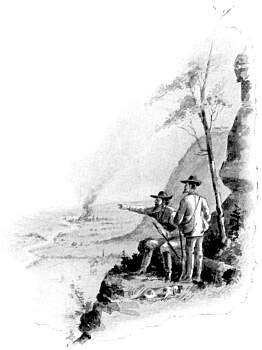|
||||||
  
 | ||||||
|
The Ulster & Delaware Railroad. The time having finally arrived for a railroad, the men were found to build it in spite of the unfavorable current of public opinion which then prevailed. Thus, the construction of the Ulster & Delaware line was begun in 1866. Proceeding slowly and cautiously for a time, the iron horse did not really get very far into the mountains until four years later. Even then the project was generally considered wild and ill-advised, with certain failure at the end. But the projectors had faith in the final result and kept stretching out the rails until they reached and crossed the mountains. Nature may never have dreamed that man would stretch a railroad
through this lovely valley, and at times there has been some question
as to whether she had been fully reconciled to the desecration,
But the engineers found a natural pass here most of the way, crooked
and tortuous though it was, and they just followed it up good
naturedly in laying out the line of the road, avoiding any aggressive
liberties with the native conditions, as far as possible. Many
heavy grades were encountered, and there was a cantankerous Mountain
creek, with a whole brood of wayward and excitable little tributaries
pouring into it from every gorge and gulch which had to be dealt
with in a dignified and earnest manner. These were normally quiet
and inoffensive, of course; the speckled trout disported lazily
in the crystal water which glittered in the noonday sun like silver
threads in the woof of the mountain, and rippled in sweet refrain
on its winding, woodland way to the river. But when the floods
came, these placid and pretty rills swelled into roaring torrents
in a few hours, tumbling into the main creek, which in turn, flooded
the narrow valley and swept everything down before it. Of course,
there was nothing about the railway that would be likely to exempt
it from this inevitable rule, or evoke any sympathy from these
arteries of the mountains. So the engineers acted squarely on
the defensive and built the road on that theory, locating the
line with the utmost care and building in the firmest manner.
The best materials The completion of the road of course proved the great factor in the development of the Catskills as a popular summer resort. A new impetus was imparted to the mountain boarding business, and hotels, large and small, began to rise here and there in the valleys and on the mountain slopes. It opened a new section of the range, which rivaled and even surpassed in beauty any other portion, while the entire region at once became easily accessible. Luxurious parlor and day coaches are now attached to the trains, and the most infirm and debilitated may thus enjoy the benefits of this great natural sanitarium.
Ulster & Delaware | Stories Page | Contents Page This page originally appeared on Thomas Ehrenreich's Railroad Extra Website
|
||||||
|
|
|
|||||



 were
used in every case, and the best methods employed to secure stability,
security, safety, efficiency and comfort. The roadbed has recently
been materially straightened and leveled, and the curves perfected
by a competent corps of engineers. This was made necessary by
the increased traffic and greater speed of trains, which also
called for heavier rails and ties and modern steel bridges, all
of which have been supplied over the entire line. Several new
and attractive station buildings have been erected, and important
additions and improvements to the rolling-stock and general equipment,
are continually being made. The new passenger locomotives are
now heavier and more powerful than formerly and they are constructed
from the latest improved designs for speed and efficiency. The
new coaches which are added each year, and elegant models of comfort
and convenience from the best shops in the country. Nothing that
will conduce to the comfort and pleasure of travelers has been
omitted in the equipment of The Ulster & Delaware system.
It therefore stands to-day second to none in security of' road-bed,
safety of appliances, general efficiency and comfort of equipment.
The policy of the company and its management is to get the best,
and operate the line in the best possible manner.
were
used in every case, and the best methods employed to secure stability,
security, safety, efficiency and comfort. The roadbed has recently
been materially straightened and leveled, and the curves perfected
by a competent corps of engineers. This was made necessary by
the increased traffic and greater speed of trains, which also
called for heavier rails and ties and modern steel bridges, all
of which have been supplied over the entire line. Several new
and attractive station buildings have been erected, and important
additions and improvements to the rolling-stock and general equipment,
are continually being made. The new passenger locomotives are
now heavier and more powerful than formerly and they are constructed
from the latest improved designs for speed and efficiency. The
new coaches which are added each year, and elegant models of comfort
and convenience from the best shops in the country. Nothing that
will conduce to the comfort and pleasure of travelers has been
omitted in the equipment of The Ulster & Delaware system.
It therefore stands to-day second to none in security of' road-bed,
safety of appliances, general efficiency and comfort of equipment.
The policy of the company and its management is to get the best,
and operate the line in the best possible manner.